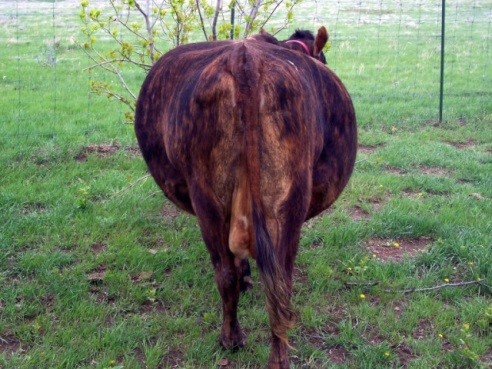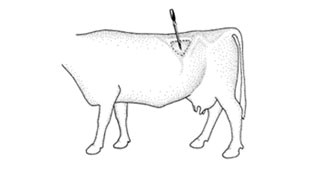Bloat is simply a buildup of gas that cannot be expelled. Amazingly, this trapped air can be fatal to both calves and adult cattle. As gases begin to accumulate, the abdomen becomes hyperdistended which can easily be spotted during herd checks. Bloat rarely resolves on its own. Without intervention, the gas pressure can rise to a point that it compresses the heart and lungs causing the animal to suffocate.
What to look for: 
- Primary sign – distention of the animal’s left side
- Obvious discomfort
- Stomping feet
- Kicking at belly
- Labored breathing
Pasture vs. Feedlot bloat:
- Pasture bloat – also called frothy bloat. Occurs in cattle grazing lush pastures heavy with legumes or being fed green-chopped legumes. Trapped gases form a foam/froth that holds gases in. There are some conditions that increase the likelihood of bloat occurring on pasture. Below average temperatures are typically associated with bloat because animals may increase their forage intake during cool weather. Bloats also tend to occur more often in the morning because cattle often consume their biggest meal at this time. Some cattle are simply more prone to bloat because of their tendency to selectively eat bloat causing plants more than others.
- Feedlot bloat – also called dry bloat. Refers to bloat in cattle fed high grain rations. Typically occurs secondary to acidosis. May be caused by grain portion of diet being too finely ground resulting in rapid digestion and subsequent gas production.
Preventing Pasture Bloat
- Avoid pastures excessively high in bloat causing legumes (alfalfa, clover, wheat, etc.)
- Feeding anti-bloating supplements can reduce bloating but are also expensive
- Proper grazing management can reduce or eliminate bloating as effectively as supplements
- Ensure pasture intakes are steady and consistent. Control access to high bloat plants.
- Avoid turning cattle out onto wet alfalfa, instead wait until dew is off and gradually introduce them to the pasture for 1 – 2 hours/day. Allowing them to graze the lush pasture and then returning them to the old pasture will allow them to slowly adjust.
- Consistent intakes of pastures with similar forage types help to provide a stable rumen environment and reduce chances of overeating.
- Avoid turning hungry cattle onto a lush alfalfa pasture. Try filling cattle with dry hay before turn out.
- Bloat Guard blocks are available to help reduce incidence of bloat as well.
Preventing Feedlot Bloat
- Feedlot bloat is often associated with acidosis. Prevent acidosis and incidence of bloat should decrease as well.
- Ionophores such as Rumensin and Bovatec appear to not only improve feed efficiency of high grain rations, but also reduce overeating and the occurrence of bloat.
- Provide adequate bunk space
- Make sure cattle are provided some hay to ensure a healthy rumen environment. Forage encourages cattle to ruminate which brings more buffer-containing saliva into the rumen for pH stabilization.
- Keep corn whole or crack coarsely to prevent acidosis. Avoid finely ground corn.
- Minimize sorting
- Carefully manage feed bunks to maintain consistent intakes and avoid fluctuations in rumen pH
Treatment
In cases of severe bloat, action may need to take place before your veterinarian arrives. These are some treatment options to alleviate the pressure; however, please consult your veterinarian to devise the best course of treatment for bloats in your cattle.
- Stomach tubing – Use either a stomach tube or rubber hose around 1 inch in diameter and 8-10 feet long. Pass the hose down the esophagus into the rumen to allow the gas to escape.
- If the stomach tube does not provide relief, an antifoaming agent may be required. Mineral oil can be used as an antifoaming agent and can be given via the stomach tube. Never drench a bloated animal as they may inhale the drench causing either immediate death or pneumonia.
- A trocar may be used as another means to relieve pressure from gas (see picture). However, consult your veterinarian before attempting anything this invasive as complications may occur.

(Information and trocar placement picture adapted from Nebraska Extension: Bloat Prevention and Treatment in Cattle.)

